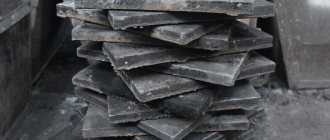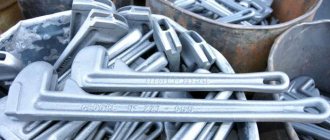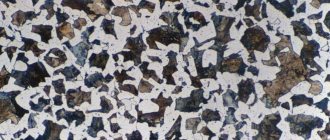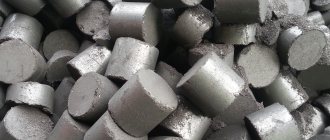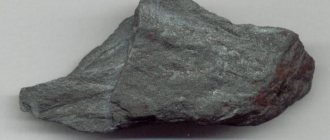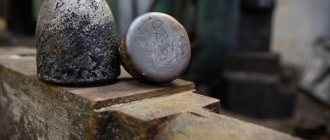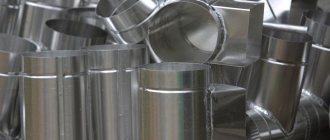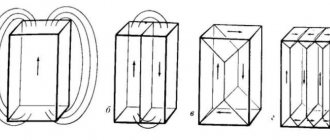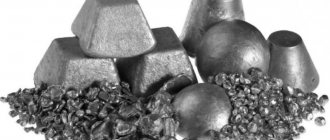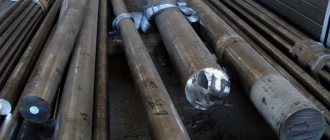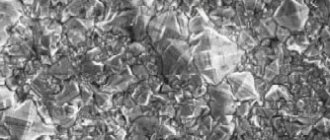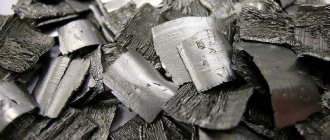Types of cast iron
The grade of a cast iron alloy is determined by the amount of carbon and other substances in its composition.
Types of cast iron
This approach allows us to distinguish the following types of this material:
- white;
- gray (GOST 1412);
- malleable (GOST 1215);
- high-strength (GOST 7293).
White cast iron
In this alloy, carbon is collected in the form of cementite. This grade of material is wear-resistant and has good hardness parameters. At the same time, it is quite poorly processed on metal-cutting equipment.
White cast iron structure
White cast iron is divided into the following groups:
- hypoeutectic with carbon concentration from 2.14% to 4.3%;
- eutectic - 4.3%;
- hypereutectic from 4.3% to 6.67%.
In other grades of cast iron, the carbon is in the form of graphite.
Gray cast iron
The carbon in this grade of cast iron is in the form of plates. Gray cast iron also contains the following components:
- silicon up to 0.8%;
- manganese up to 0.3%, etc.
Microstructure of gray cast iron
To produce castings from this material, molds made of cast earth or steel are used. Such forms are called chill molds. The key area of use of gray cast iron is mechanical engineering. It is used to make structures that operate when there are no shock impacts, for example, wheel V-belt drives, bearing cups, etc. A cast iron alloy of this type is marked as follows: SCH 32 - 52. The first number shows the tensile strength, the second the bending limit.
Malleable iron
As part of this material, carbon has a flocculent shape. The chemical composition of this material includes up to 1.4% silicon, 1% manganese, etc. Malleable cast iron is made from white cast iron.
Malleable iron
To do this, it is subjected to heat treatment, that is, it is heated and kept in this state for the time specified by the technology. This operation is called languishing. Malleable cast iron is marked as CN 45 - 6. The first number indicates tensile strength, the second elongation as a percentage.
Ductile iron
As part of this cast iron, carbon has a spherical shape. To produce cast iron of this type, modification is used, that is, magnesium is introduced into the melt. It ensures the formation of carbon in the form of spherical inclusions. This solution made it possible to bring cast iron of this grade closer to carbon steels in a number of properties. Its casting parameters are greater than those of other brands of cast iron alloys, with the exception of gray.
Ductile iron
Cast irons of this class are used in the production of such parts as pistons, crankshafts, and components of braking systems.
High-strength cast iron is marked as follows - HF - 45-5. The first number indicates the tensile strength, the second the percentage elongation.
Main menu> | Study work
Graphitized cast irons
Depending on the shape of the graphite inclusions, gray, high-strength, malleable cast iron and cast iron with vermicular graphite are distinguished.
Gray cast iron
obtained at a lower casting cooling rate than white castings. They contain 1–3% Si, which has a strong graphitizing effect.
Gray cast iron is widely used in mechanical engineering. It can be processed well with cutting tools. It is used to produce machine beds, cylinder blocks, foundation frames, cylinder liners, pistons, etc.
Gray cast iron according to GOST 1412–85 is marked with the letters “СЧ” and is followed by the tensile strength value (in kg/mm2
), for example SCh 15, SCh 20, SCh 35 (Table 1).
Graphite in gray cast iron is observed in the form of dark inclusions on a light background of an unetched section. The shape and dispersion of graphite, on which the mechanical properties of gray cast iron largely depend, are assessed from an unetched section.
Gray cast irons are divided according to the microstructure of the metal base, depending on the completeness of graphitization.
The degree or completeness of graphitization is assessed by the amount of freely released (unbound) carbon.
The completeness of graphitization depends on many factors, the main ones being the cooling rate and the composition of the alloy. With rapid cooling, the formation of cementite rather than graphite is kinetically more favorable. The slower the cooling, the greater the degree of graphitization. Silicon promotes graphitization, and manganese, a carbide-forming element, hinders graphitization.
Rice. 3. Diagrams of microstructures of graphitized cast irons: a) gray; b) high strength; c) malleable; d) with vermicular graphite
If graphitization in the solid state is complete, then cast iron contains two structural components - graphite and ferrite. This alloy is called gray cast iron on a ferritic basis (Fig. 3, a). If the eutectoid decomposition of austenite took place in accordance with the metastable system
then the structure of cast iron consists of graphite and perlite. This alloy is called pearlite-based gray cast iron. Finally, an intermediate option is possible when austenite partially decomposes by eutectoid reaction into ferrite and graphite, and partially with the formation of pearlite. In this case, cast iron contains three structural components - graphite, ferrite and pearlite. This alloy is called gray cast iron on a ferrite-pearlite base.
Ferrite and pearlite in the metal base of cast iron have the same microstructural characteristics as in steels. Gray cast irons contain an increased amount of phosphorus, which increases fluidity and produces a triple eutectic.
In the metal base of gray cast iron, phosphide eutectic is found in the form of light, well-defined areas.
Ductile irons
with nodular graphite are obtained by modifying gray cast iron with alkaline earth elements. More often, magnesium is used for this, introducing it into the liquid melt in an amount of 0.02–0.03%. Under the influence of magnesium, graphite crystallizes in a spherical shape (Fig. 3, b). Spherical graphite inclusions in a metal matrix are not as strong stress raisers as graphite plates in gray cast iron. Nodular cast irons have higher mechanical properties that are not inferior to cast carbon steel.
High-strength cast iron is marked according to GOST 7293–85 with the letters “HF” and then follows the value of the tensile strength (in kg/mm2
), for example HF 40, HF 45, HF 80 (Table 2). Just like gray cast irons, they are divided according to the microstructure of the metal base depending on the completeness of graphitization and can be ferritic, ferrite-pearlitic and pearlitic. High-strength cast iron is used in many areas of technology to replace cast and forged steel, gray and ductile cast iron. High mechanical properties make it possible to widely use it for the production of critical-use castings, including in marine engineering: cylinder heads, turbochargers, pressure pipes, crankshafts and camshafts, etc.
Malleable cast irons
obtained by annealing white cast iron castings.
The production of malleable cast iron is based on the fact that instead of the unstable cementite of white cast iron, annealing graphite of white cast iron is formed at elevated temperatures. Small products of complex configuration, cast from white cast iron, are annealed (malleable cast iron is obtained) to impart sufficient ductility necessary for their use in work. Malleable cast iron according to GOST 1215–79 is marked with the letters “KCh” and is followed by the value of tensile strength (in kg/mm2
) and relative elongation (in%), for example, KCh 35-10, KCh 60-3 (Table 3) .
Graphitization occurs through the dissolution of metastable cementite in austenite and the simultaneous separation of more stable graphite from the austenite. The longer the holding time during annealing and the lower the cooling rate, the more complete the graphitization occurs. Depending on the graphitization, the same three main types of structures are found as in gray cast iron: malleable cast irons on ferritic, ferrite-pearlitic and pearlitic bases (Fig. 3, c). Ductile cast irons differ from gray (foundry) cast irons in microstructure only in the form of graphite.
If in thin sections (Fig. 3, a) of gray cast iron graphite has the form of tortuous veins, then in malleable cast iron graphite, called annealing carbon, is in the form of more compact flake-like inclusions with torn edges. The more compact form of graphite provides increased mechanical properties of ductile iron compared to gray cast iron with flake graphite. Having mechanical properties similar to cast steel and high-strength cast iron, high resistance to impact loads, wear resistance, and machinability, ductile cast iron finds its application in many industries. Pistons, gears, connecting rods, brackets, porthole rings, etc. are made from it.
Cast irons with vermicular graphite
They are obtained, like high-strength cast irons, by modification, only a complex modifier containing magnesium and rare earth metals is introduced into the melt.
Cast irons with vermicular graphite are marked according to GOST 28394–89 with the letters “ChVG” and followed by a number indicating the value of the tensile strength ( kg/mm2
), for example, ChVG 30, ChVG 45 (Table 4). Vermicular graphite, like lamellar graphite, is visible on a metallographic section in the form of veins, but they are smaller, thicker, with rounded edges (Fig. 3, d). The microstructure of the metal base of ChVG, like that of other graphitized cast irons, can be ferritic, pearlitic and ferrite-pearlite.
In terms of mechanical properties, cast irons with vermicular graphite are superior to gray cast irons and are close to high-strength cast irons, and the damping capacity and thermophysical properties of CCG are higher than those of high-strength cast irons.
Cast irons with vermicular graphite are more technologically advanced than high-strength cast irons and compete with gray cast irons. They are characterized by high fluidity, good machinability, and low shrinkage. Cast irons with vermicular graphite are widely used in the global and domestic automotive industry, tractor manufacturing, shipbuilding, diesel engineering, power and metallurgical engineering for parts operating under significant mechanical loads under conditions of wear, hydrocavitation, and variable temperature increases. For example, ChVG is used for the production of cylinder covers and liners, pistons for ship and diesel engines, gas turbine and compressor casings. Top of page
Features of the production of malleable cast iron
The production of KCh cast iron has a number of subtleties that are determined by casting characteristics and other properties.
Ductile iron production
Cast iron of the BC grade, which is the main product of malleable iron, does not have very good casting parameters. In particular, it has reduced fluidity, a large amount of shrinkage during cooling, and it is prone to the formation of various casting defects. These are the reasons why during production it is necessary to overheat the metal and take measures to combat casting defects. The production of malleable cast iron can be carried out with the obligatory consideration of shrinkage and changes in the dimensions of the workpieces during simmering. Thin workpieces have maximum shrinkage, thick ones have minimal shrinkage. The simmering operation is performed at 1350 - 1450 degrees Celsius.
Annealing (simmering) is a basic step in the production of cast iron. It is produced in separate workshops called languid. The preparations are placed in pots made of steel or cast iron alloys of different grades for simmering. Up to 300 castings can be placed in a pot, based on the fact that up to 1,500 kg should be per cubic meter.
Malleable cast iron gains its greatest strength in pots made from white cast iron with chromium additions and a minimum amount of phosphorus. The consumption of pots is measured by weight; it can range from 4 to 15% of the weight of the workpieces. That is why increasing their durability plays a big role in determining the cost of finished malleable cast iron.
To avoid warping of the finished castings, placing the blanks in pots must be done with special care. They are laid as tightly as possible; to enhance the effect, the workpieces are sprinkled with sand or ore. These materials protect the workpieces from deformation and excess oxidation.
Iron production
Electric furnaces are used to produce malleable cast iron. This is due to the fact that during the simmering process it must be possible to regulate the temperature, a sharp rise during heating and a rapid decrease at the stage of its graphitization. In addition, it will not be superfluous to be able to adjust the air mixture in the oven.
Most of the furnaces used to produce malleable cast iron are muffle furnaces. That is, the products of fuel combustion do not come into contact with the pots in which the workpieces are placed.
Castings made from malleable iron go through a cleaning operation several times, and after annealing, feeders are removed and straightened. The first cleaning is carried out to remove residual molding sands. For cleaning, sandblasting equipment or special tumbling drums are used. Removal of feeder residues occurs using emery cloth.
Malleable cast iron defects
The most common defects in malleable cast iron are the following:
- shrinkage cavities;
- underfilling;
- cracks, etc.
Some defects cannot be corrected by further heat treatment. It should be noted that the production of malleable cast iron requires strict compliance with all GOST requirements, technological rules and regulations. Only in this case can we talk about obtaining high-quality malleable cast iron, which can be used to replace other, expensive materials - steel, non-ferrous metals.
Types of malleable cast iron
The grade of cast iron alloy KCh is directly related to the conditions under which annealing is carried out. After this operation, three classes of cast iron are obtained:
- ferritic;
- pearlite;
- ferritic-pearlitic.
The first contains in its chemical composition ferrite and carbon of a flocculent structure. The second includes pearlite and graphite with a flocculent structure. The third contains ferrite, pearlite and flake-like carbon.
Types of malleable cast iron
Malleable pearlitic cast iron results from rapid cooling of the workpiece while it is in the decomposition zone. In this case, in addition to ferrite, the structure of cast iron will contain pearlite. It will persist even with further cooling of the workpiece to a temperature lower than 727 degrees.
That is, we can say that the structure of cast iron is strictly related to the annealing temperature conditions and the presence of alloying components.
Varieties
In the production of high-strength cast iron alloys, different conditions are created under which the annealing procedure is carried out. Depending on changes in the technological process, three types of malleable cast iron are obtained:
- Pearlitic - this material contains flake-shaped graphite particles.
- Ferritic - This material includes ferrite and flake-shaped carbon particles.
- Ferritic-pearlitic. A mixture of the two previous types of malleable cast iron.
Depending on the annealing temperature and alloying additives, the characteristics of the finished material change.
Main characteristics of the metal
The key parameters of cast iron are determined by the amount of carbon, which has the form of graphite, and the presence of silicon. Pearlitic malleable cast iron alloy contains two more constituent elements - chromium and manganese.
Characteristics of Ductile Iron
The difference in the structure of malleable cast iron is also reflected in the final properties of products obtained from it. For example, workpieces made from ferritic cast iron have lower hardness than those made from pearlitic material, but at the same time the former have increased ductility. Graphite in the form of flakes provides high strength parameters to finished parts with relatively good ductility. Products made of KCh cast iron can be deformed at room temperature and humidity. It was this property that determined the name of this material – malleable. In fact, this is a conditional name and does not mean that finished parts are obtained from it using forging equipment. Casting is used to produce products. The main property of this material is that there is no stress in it.
Microstructure of ductile iron
The mechanical properties of ductile cast iron are between gray cast iron and steel. That is, cast iron of this type has high fluidity, resistance to wear, corrosion, and aggressive substances. In addition, this material has high strength properties. Thus, a part with a wall thickness of 7–8 mm can withstand working pressure of up to 40 atm. This allows it to be used for the manufacture of pipeline fittings for gas and water.
We must not forget that at low temperatures, cast iron becomes very brittle and is very susceptible to impact.
Properties of malleable cast irons
The basic property of the KCh cast iron alloy is that it contains carbon inclusions in different forms, which determines its strength and ductility. Cast iron with a low amount of carbon (decarbonized), in fact, is the only material from structural cast iron alloys that is well welded and is used to produce welded metal structures. For welding, either gas protection or butt technology is used. This grade of cast iron lends itself to pressing, embossing and quite simply fills voids and gaps. Parts made from a malleable ferritic cast iron alloy are subjected to cold processing, while parts made from pearlitic alloy are heated.
The cast iron used in production is made from a white cast iron alloy by annealing it. The structure obtained after performing this operation may have a ferritic or pearlitic form.
One of the advantages of a malleable cast iron alloy is that it has uniform cross-sectional properties; in addition, it is well processed on turning-milling machines.
The main physical and technical parameters of a malleable cast iron alloy are standardized in GOST 1215-79. The marking of this material is based on permissible tensile and elongation values. The hardness of the material is determined by the structure, and the strength parameters and ductility are determined by the presence of graphite.
It must be understood that the properties of the material are affected not only by the shape, but also by the amount of graphite contained in the alloy. Malleable cast iron reaches its maximum strength characteristics in the presence of fine pearlite and a small amount of graphite. The maximum ductility and toughness of cast iron of this class is achieved in the presence of ferrite and the same amount of graphite.
Properties
The mechanical properties of cast iron directly depend on how much carbon it contains and in what form this component is presented. Characteristics may vary due to the addition of alloying impurities. These include silicon, manganese, sulfur, phosphorus and chromium. This material is made from white cast iron after annealing at high temperatures. Properties of malleable material:
- High strength and ductility.
- Good viscosity.
- The material has high wear resistance.
Ductile iron is the best type of base alloy. Massive structures are made from it, the individual parts of which are connected using welding equipment.
Scope of application
Malleable cast iron has found its application in mechanical engineering for the production of machine tools, individual car parts, structures and mechanisms used in railway transport, etc.
Most often, ferrite castings are used, which are somewhat cheaper than all others. Perlite castings are used for the manufacture of parts that are used for products and assemblies operating under increased loads.
Malleable cast iron is used to produce castings with a thin wall; its size can range from 3 to 40 mm.
Areas of use
Due to its characteristics, malleable cast iron is widely used in various industries:
- Production of products and parts that will be subject to severe loads during operation.
- Mechanical engineering.
- Agricultural industry.
- Manufacturing of parts for industrial equipment and machine tools.
Malleable cast iron is used to make mechanisms, structures and parts that are used in the operation of railway transport. A striking example of the use of this material in mechanical engineering is the manufacture of crankshafts that are installed in diesel tractors and cars. The low price and characteristics of this metal allow it to be used as an analogue to various types of steel.
Malleable cast iron is an alloy of iron and carbon. It is made from warheads through the annealing process. The result is a unique material with its own characteristics. Used in mechanical engineering, construction, production of parts for trains and wear-resistant equipment, machine tools.
